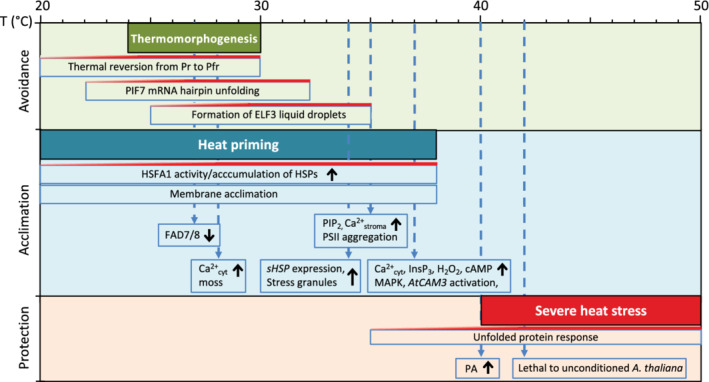FIGURE 1.

Schematic overview of responses in different warm temperature ranges. Plants display a wide array of responses when they experience above optimal temperatures. At warm ambient temperatures, up to 30°C, Arabidopsis responds by changes in morphology and development, called thermomorphogenesis, which could aid in avoidance of future heat stress. Thermomorphogenesis features the temperature‐sensitive function of phyB. Furthermore in this temperature range, there is thermosensitive regulation of PIF7 mRNA translation. Warm temperatures alter the structure of a hairpin structure in the mRNA of PIF7, which promotes its translation. ELF3 undergoes temperature‐dependent phase separation. High temperatures promote condensation of ELF3, and the inhibition of ELF3‐DNA binding. Under mild heat stress, that is, at temperatures of 30–38°C, Arabidopsis initiates acclimation responses that counteract damage to proteins and membranes, and maintain cellular homeostasis. The suite of physiological changes associated with acclimation enhances plant thermotolerance. This involves the activity of HSFA1 master transcriptional factors (Liu & Charng, 2013). HSPs/sHSP accumulate to limit misfolding of proteins, and stress granules, biomolecular condensates in the cytosol and chloroplast, form to sequester mRNAs and proteins. The membranes' lipid compositions are adjusted so as to prevent disruption of the bilayer structure due to uncontrolled increases in membrane fluidity. The heat sensors that activate acclimation are unknown. The accumulation, within the first ±15 min of heat stress, of putative signalling components, such as Ca2+, H2O2, PIP2, PA and cAMP suggests their function in heat perception, closely tied to the sensor. Temperatures above 40°C are damaging to Arabidopsis, and all responses in this range are devoted to immediate protection or controlled breakdown of cellular structures. Mechanisms of clearance and rescue of unfolded proteins, including the UPR, are important for survival of severe heat stress. These heat stress responses partly rely on the recognition of unfolded proteins in the ER, the cytosol and diverse organelles
